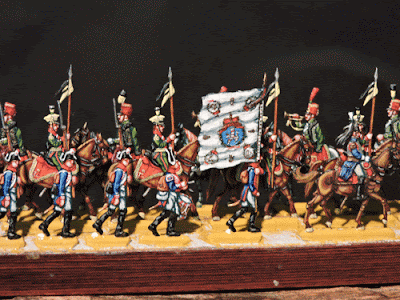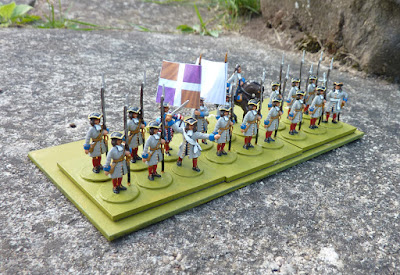This week I was handed a dose of Real World which has effectively put a stop to much of what I had been hoping to do over the Summer. With luck, I expect to get through this, and in the short term I now have a chance to clear up some odds and ends which have been dragging on a bit while I was indisposed with the Plague.
Topic 1: Another French WSS unit nearing completion
Last night I finished what may be my last refurbishment job for my WSS project. I completed 14 figures for the 18-man Régiment de Languedoc - there are still another 4 figures to be painted from scratch, but that should be very straightforward, and the refurb work is done. This batch has been a bit arduous, to be honest.
At the start of the French phase of my project, I identified a lot of pre-painted figures from Eric Knowles' collection which could be restored to fill the ranks in my new army. Some of these needed only very light re-touching, so I prioritised those, but as I worked my way through I got to some more battered and re-hashed units, and this last lot was really pretty marginal; I might have been better stripping and starting again, and I think my decision to persevere with restoring them was influenced by a wish to keep Eric's old soldiers on the march as far as possible. Eric might not have recognised some of them now, but I'm pleased with what's been achieved.
The effort required for this batch wasn't helped by a historic decision by someone (many years ago) to improve a nicely-painted regiment by the addition of sawdust, Russian toffee and henhouse-green paint to the bases. Well, in many cases, to the area below the soldiers' knees. Yuck. It's taken me about 2 weeks of soaking and scraping to get it off, but it is now gone.
Anyway, as of this morning, here are the 14 restored fellows, with the glue drying, waiting for a new mounted officer, two ensigns and a drummer to complete them. I'll post a smart photo once they are ready for action.
Topic 2: A Very Old Brush
I've maybe mentioned this brush before, but I was working yesterday with a brush which is certainly the oldest I have, I wonder how long these things last? When my dad died, 14 years ago, I helped my mother to clear out all his old art materials; he had been a keen watercolourist, but hadn't been near the hobby for years.
There were all sorts of solidified paints, and a good number of very old brushes, most of which disintegrated to dust when I rubbed the bristles. However, there were a couple of brushes which he had obviously used, and they still felt OK. I destroyed one a few years ago when I accidentally got superglue on the bristles, but the other is still going strong. Here it is, in the foreground, in action yesterday:
I use this a lot for (for example) applying baseboard-green paint to the bases of my figures, a situation in which I would not choose to involve any of my Series 7 brushes, since the paint is simply latex emulsion paint for interior walls, and they get bunged up.
Things get a bit more sinister if you check the other side of this brush.
The logo indicates that it comes from HM Stationery Office, was from the 1966 stock, and must have been liberated from the drawing office at the UK Atomic Energy Authority's electrical engineering section at Risley, Lancashire, when my dad worked there as an engineer in the 1970s. I also found a large number of high-quality boxed
Beryl pencils - mostly sketching grades like 2B, which is not a lot of use to me - which may have been liberated around the same time. I prefer not to believe that my dad was in the habit of nicking stuff from work, so I'm sure there must be a more comfortable explanation if I could just think of it...
Anyway, my point is that I have a sable brush here which was new in 1966, which my dad must have used for his watercolours from about 1969-1978, and which I have been using regularly for my wargame painting since 2008. I guess the amount of use is probably not as high as you might estimate, but I'm astonished that the sable bristles are still in good shape. It is just one of my "gash" brushes - it gets no special treatment.
Anyone got an older brush which is still in use?
Topic 3: Some Thoughts about Shiny Soldiers
In a convoluted way, this follows on from a conversation I had with Stryker recently, about the implications of applying gloss varnish to miniature soldiers, and what defines an "appropriate" painting style for the Shiny Brigade. Rather famously, he has been doing this for years with his beautiful Napoleonic Hinton Hunts, but it is a new departure for me, starting with my new involvement at the end of 2019 in the Malburian period .
Deciding which bottle of varnish to use to finish your soldiers seems like a mere detail, though there are practical considerations, such as the common trick of using gloss varnish followed by matte, to give a hard-wearing coat. I'm concerned in this note mainly with the "look" of the soldiers, and with some things I have learned about my reaction to my own shiny armies. This will all be extremely personal - what I like and what I'm trying to achieve with my collection will certainly be regarded as strange, or even unacceptable, to others. Some things which I hadn't really thought about became apparent when I started working on the armies. I developed some preferences and some definite views which I hadn't considered previously.
First thing, which came as a bit of a surprise, is that I find that what I'm putting together is not a museum of perfect historic miniatures, or a miniature facsimile of a real army, but is just a collection of toy soldiers. Yes - toys. It's OK - I enjoy, nay, celebrate the fact that they are toys!
Last week I watched the first of the later, colour episodes of Callan, from UK TV back in 1970. Illustrative point. It turns out, you see, that Callan has been moved into a different apartment after his spell in hospital, and his colleague, Cross (Patrick Mower - I hope you're taking notes here), teases him about his box of "toys". Callan gets very scratchy about this, and insists that they are "model soldiers". This is where Callan and I part company; I would have been quite happy that they be regarded as toys. In any case, Patrick Mower spent his later career stuck in some ghastly UK TV Soap [Emmerdale], so in the long run he is in no position to make fun of Callan's toys. [Bastard].
Callan keeps his entire collection of model soldiers in a single "Banner" shirt box. Even in 1970, that makes him a dabbler in my book...
Here are some thoughts, in no particular order.
* If I were to paint up a beautiful little model of a WW1 machine-gun team for wargaming, complete with basing involving mud, wire and sandbags, I would never think of giving it a shiny finish. Without pondering too hard about it, it just feels wrong.
* So, if my WSS collection are toys, why? What's the difference?
* I read an article somewhere which suggested that maybe it makes the dreadful idea of conflict and slaughter more acceptable as an entertainment, if the participants are toy-like, and the game is abstracted to the point where there are no dead men or horses cluttering up the field? - Interesting, and possible, but that's not my chief driver, I think.
* A lot must be to do with my figure supplier. I go on rather a lot about the old Les Higgins castings I use - probably rather more than general levels of interest might justify. In the past I've had appreciative comments from John Ray and from David (of the Not By Appointment blog), both men of refined tastes, about the realistic human proportions of my toys, and the elegance of the sculpture. Cue a round of applause for the late Les Higgins. But there is something more here: the stylised poses, the delicacy of the little men, their strangely androgynous appeal, the bobbed hair, the shapely calves in stockings...
Joli Tambour. You may join me in observing that this picture from an ancient children's book seems to show a drummer wearing the French King's Livery [Lee will especially appreciate this]
Nailed it.
These guys are straight out of the French nursery-rhyme books of my childhood, when pretty drummer boys caught the eye of the King's daughter, and all that. They do not have smelly feet, or buck teeth, or outsized, garden-gnome hands; they do not relieve themselves behind your hedge, or burn down your barn - they are just lovely toys, of a very old-fashioned style. Thus it suits me to paint and present them as such, with appropriate overtones of a bygone age, and toy soldiers have to be shiny; it's as natural as, well, something or other that I can't quite put my finger on at the moment.
There are implications, some of them not obvious, for painting, and I have to thank Lee and Goya and a couple of other kind souls who have generously suppressed some elements of their natural painting styles in support of this idiosyncrasy of mine; if the painting is too impressionistic or too layered then gloss varnish can produce bizarre results. A simple, colourful style lends itself well to the presentation, and the toy units will then move around the field in colourful, rigid formations. They can fight Schellenberg if you wish, but it will be Toy Schellenberg - as my brain ages, I find that my rules are becoming more toy-like, as well.
When I started on this, I had very little idea what I was aiming for, other than clues I could get from what Eric and others had done before me, but what is evolving is a little, personal subculture and some better developed guidelines on how I like things done. This is not based on any series of decrees; I have rarely said, "this is how it will be", but I have frequently said, "Gosh, I really like that", and very occasionally I have said (of my own work), "oops...".
Quite soon, when my WSS Phase 1 is complete (the delay is likely to be associated with non-appearance of staff figures, but I'm working on that), I'll produce full team photos and pay tribute to the heroes who have helped me so much over the last couple of years, but I haven't quite got there yet. I'm constantly amazed by how much I have learned along the way.



















